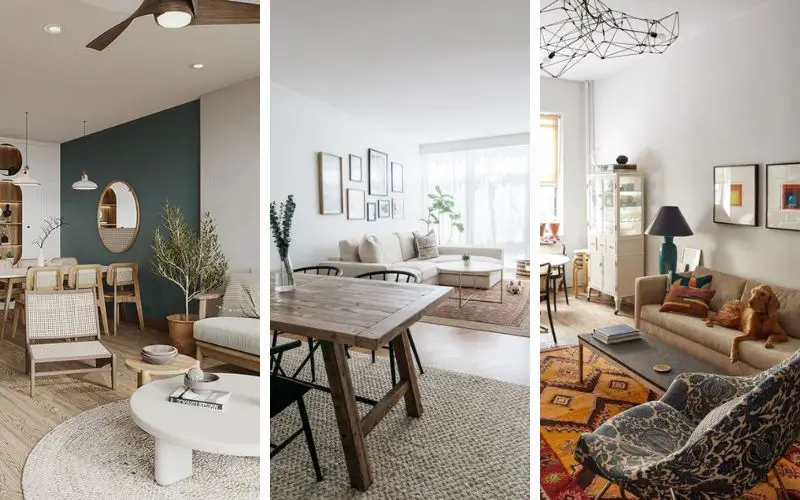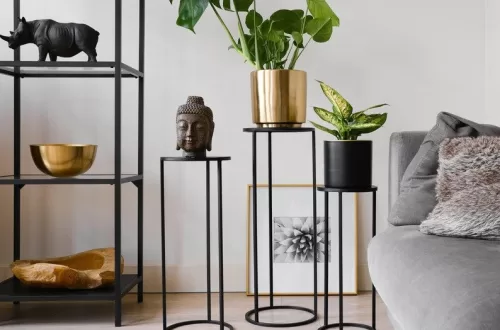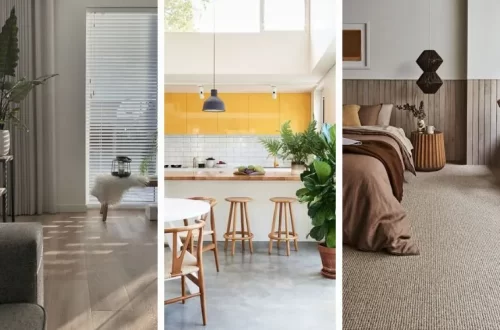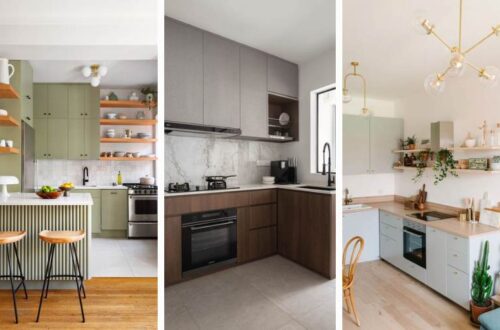
Living and Dining Room Combo Decor Tips
Share this
If you have a living and dining room combo, it can be tricky to create a cohesive and inviting space.
Fortunately, there are plenty of ideas to kickstart your creativity and make your integrated dining room feel cozy and look spectacular.
Let’s delve into all kinds of tips and tricks, from placement of furniture to accent colors and decorating ideas.
I’ll share some designer tips and plenty of inspiring pictures to help you envision your own ideal dining room.
Whether you’re looking for a sleek, modern style or prefer classic elegance, this article is sure to offer something to suit your tastes.
So sit back and prepare to elevate your living and dining room combo to a whole new level!
1 | Define the space in the living and dining room combo
Arranging furniture in a home can be a challenge, but with some key considerations, it can be easier to tackle.
Defining the zoning areas of a living and dining room combo is particularly important.
With this in mind, entry and exit areas, windows, and architectural features must be considered.
Another crucial factor is personal habits and how different areas of the home are used.
When arranging furniture, it’s important to start with larger pieces first before adding smaller details.
Placement of furniture near important areas, like the kitchen, is also a key consideration.
The “integrated” layout is ideal for smaller living and dining room combos and allows for fluid movement between the two spaces.
This option creates a visual separation without using walls or additional furniture.
By considering these factors, it’s possible to create an inviting and functional living and dining room combo.

2 | Furniture placement
In a living and dining room combo, it’s easy to fall into the habit of always lining up your furniture against the walls.
While this may seem like the best use of space, it can actually create a vast, empty expanse that feels unwelcoming and sterile.
To make these integrated spaces feel more inviting and intimate, consider breaking with tradition and placing your furniture in the center of the room instead.
Simply adding a rug can help define the space and add warmth, while bringing pieces like credenzas and bookcases into the mix can make the room even more functional.
And by creating a more cozy atmosphere, you’ll find it easier to engage with guests, making it the perfect setting for sharing meals, drinks, and conversation.
3 | Focal point
With shared spaces, it can be challenging to create a cohesive and visually pleasing space.
The key element to achieving this integration is the creation of a focal point.
The focal point serves as a guide for the eye and mind, helping to avoid mental saturation and create a smooth visual flow.
In smaller living and dining room combos, a single focal point may be the best option.
This will help to guide the eye more easily and reduce information overload.
Popular options for focal points in these spaces include a ceiling lamp over the dining room, TV in the living room, wallpaper in the dining room, or a large painting.
Talking about wallpaper and wall art, let me tell you about Photowall.
This company more than just a decorative covering for your walls; it is a statement piece that enhances any room’s style and ambiance.
Whether you’re looking to create a cozy living area or a chic workspace.
You can choose from a wide variety of designs, from bold and bright patterns to muted and subtle prints.
It is easy to install and maintain, making it a cost-effective way to update your home decor.
Check out their massive selection of wallpaper, posters, and mural here.
However, in larger spaces, multiple focal points can provide the necessary visual stimulation to avoid boredom.
No matter the size, a well-chosen focal point will successfully draw the eye and mind toward areas of importance and create an integrated, harmonious space in a living and dining room combo.

4 | Colors
When it comes to designing, the use of color is a crucial aspect that shouldn’t be ignored.
A unified and cohesive space can easily be achieved by using the same color for your baseboards and moldings throughout the entire area.
However, before deciding on your accent colors, it’s important to establish a neutral base color that will tie everything together.
The accent colors should be distributed strategically throughout the space to create a sense of repetition and rhythm.
Don’t feel like you have to use the exact same tone everywhere – it’s perfectly fine to vary the shades a bit to add in interest.
Lastly, consider incorporating warm textures like wood, leather, and ceramics to contribute to the overall unity of the space.
5 | Shopping without a plan
When it comes to furnishing a home, it’s easy to get drawn into the world of impulse buying without a clear plan.
However, before diving into the world of interior design headfirst, it’s crucial to understand how every space in a home integrates with one another.
This is especially important when dealing with living and dining room combos since they serve as the primary gathering spot for families and friends alike.
It’s crucial to define your style beforehand, as consistency of design elements is key to achieving harmony throughout a home.
Mismatched colors and materials, such as straw and leather, can cause a lack of coherence between rooms and distract from the overall aesthetic.
Ultimately, planning and a clear understanding of your design style can make all the difference in creating a cohesive and beautiful space.
6 | How to decorate a large wall
Decorating a home with elongated and uninterrupted walls can be a challenge, especially when dealing with a living and dining room combo.
However, there are several strategies to make the most of this type of space.
Using consistent color throughout the wall, avoiding divisions, and highlighting beams and columns can help create a harmonious composition.
Decorative elements such as pictures, mirrors, and wall lamps are also useful in adding life to the wall.
Adding cladding materials like wood, stone, or brick can also add interest for a unique and textured look.
Built-in shelving can provide both functionality and design on the long wall.
When designing along the entire length of the wall, proportions and transitional elements should be considered.
Furniture pieces like credenzas or console tables can act as transitional elements between two areas.
Lastly, plants can also serve to unite and define both areas on the elongated wall.

7 | Lamps
The lamps used can vary in color, but should contribute to an engaging atmosphere.
Start by placing general lighting throughout the space to provide light, then add decorative lamps to show off style.
If the feel of the room is industrial, lamps made of wrought iron or aged finishes work well.
Varying lamp heights and locations creates a cozy yet contrasting effect.
To ensure cohesion, coordinate lamp colors, textures, and materials.
The lamps do not need to be identical, but should connect in at least one way like shape and color.
Even lighting levels throughout the room are important to avoid areas being too bright or dark, so balance is key.
8 | Vertical furniture
When it comes to designing a living and dining room combo, versatility is key.
Furniture and accessories that can perform multiple functions and adapt to different needs and design configurations are a must-have in order to make the most of the shared open space.
Chairs or armchairs in the living room can easily transition to the dining area to provide additional seating for a dinner party.
Ottomans can also serve as versatile additions to the dining room, accommodating guests without having to compromise on the overall style of the space.
Modular furniture systems offer even greater flexibility, allowing for custom configurations according to needs at any time – perfect for a modular sofa that separates living and dining areas for greater integration during a dinner party.
9 | Plants
Incorporating plants into the space can provide much-needed visual interest.
When all elements are the same height and flat, the space can feel dull and uninviting.
Introducing taller plants that direct attention upwards is an excellent way to break up uniform heights and add a little drama.
Additionally, placing plants in corners is an effective method of utilizing otherwise-unused space for height variation.
When tall plants are used where spaces meet, they can act as subtle dividers without blocking any views or disrupting the flow of the room.
By incorporating plants into your living and dining room combo, you can add a fresh and lively touch to the space.
Read more about interior plants here.

10 | Rugs
Rugs are not only a beautiful addition to a space, but they can also define and separate areas without harshly dividing them.
By placing a rug under your dining room table, you can create a clear and defined space for meals and entertaining.
While adding a rug to the living room can provide definition to each individual area, it is important to choose a rug with a similar tone to the floor or furniture for a subtle effect.
In smaller spaces, this soft contrast between textures can actually make the space appear larger.
However, in larger spaces, a more striking visual effect can be achieved by opting for a rug with more details or patterns.
At the end of the day, where you place your rugs depends on your individual preferences, but they can certainly add a cozy and visually appealing aspect to your space.
11 | Decoration
When it comes to a living and dining room combo, the space should reflect your lifestyle, needs, and tastes.
One way to achieve this is through integrated spaces that contain good decorative elements like vases, bowls, trays, and cushions.
To really tie the areas together, decorative pieces in both rooms should connect through material or tone.
For example, matching an accent chair’s wood tone with a dining area item can easily bring the two spaces together.
Another option is to use a simple bowl or tray which can connect the dining and living areas through shared material.
Consider using metal decorative objects in the living room that match pieces in the dining room as well.
By repeating decorative elements and materials, you’ll easily integrate these two rooms. Ultimately, personalizing the space with your unique style will make it feel like home.
12 | Circulation
Circulation and furniture placement are paramount to achieving ease of movement throughout the room.
Zigzagging furniture may create a unique look but can also present unexpected obstructions.
Leaving insufficient space between furnishings can inhibit comfortable passing and cause an overall feeling of clutter.
Additionally, blocking passage areas or placing furniture near doors can impede traffic flow, leading to a feeling of discomfort.
It’s important to prioritize usability over decoration to guarantee easy and comfortable mobility throughout the space, allowing for smooth traffic flow and unobstructed access to doors and entrances.

13 | Design
Designing a living and dining room combo can be a bit of a challenge, especially when it comes to creating a balanced atmosphere.
The key to achieving a harmonious integrated space is by ensuring visual balance.
Avoid concentrating all the furniture on one side while leaving the other side empty or lightly weighted- it creates an unbalanced and uncomfortable living space.
To create balance, both sides of the room should have a similar visual weight.
However, the number of elements doesn’t need to be the same, but it’s essential to consider the materials and shapes of objects.
Playing with color and texture contrasts or placing art, fireplaces, or furniture on one side can help create focal points that ensure the open concept living and dining room feels equally full and balanced.
If you’re interested in interior design and want to continue expanding your knowledge, I highly recommend checking out the following articles.
They’ll help you delve deeper into the world of design and provide valuable tips and insights to help you create stunning spaces that are both functional and beautiful.




